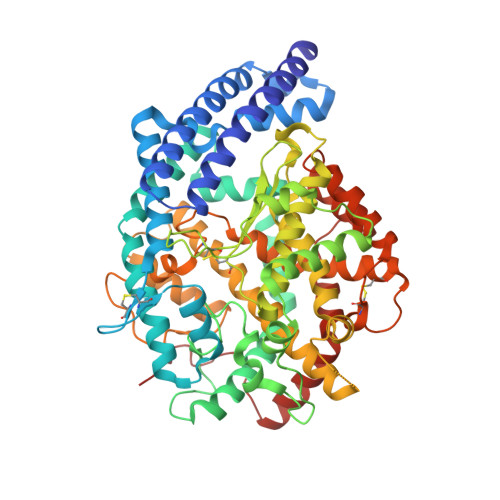Molecular and Thermodynamic Mechanisms of the Chloride Dependent Human Angiotensin-I Converting Enzyme (Ace)
Yates, C.J., Masuyer, G., Schwager, S.L.U., Mohd, A., Sturrock, E.D., Acharya, K.R.(2014) J Biol Chem 289: 1798
- PubMed: 24297181
- DOI: https://doi.org/10.1074/jbc.M113.512335
- Primary Citation of Related Structures:
4C2N, 4C2O, 4C2P, 4C2Q, 4C2R - PubMed Abstract:
Somatic angiotensin-converting enzyme (sACE), a key regulator of blood pressure and electrolyte fluid homeostasis, cleaves the vasoactive angiotensin-I, bradykinin, and a number of other physiologically relevant peptides. sACE consists of two homologous and catalytically active N- and C-domains, which display marked differences in substrate specificities and chloride activation. A series of single substitution mutants were generated and evaluated under varying chloride concentrations using isothermal titration calorimetry. The x-ray crystal structures of the mutants provided details on the chloride-dependent interactions with ACE. Chloride binding in the chloride 1 pocket of C-domain ACE was found to affect positioning of residues from the active site. Analysis of the chloride 2 pocket R522Q and R522K mutations revealed the key interactions with the catalytic site that are stabilized via chloride coordination of Arg(522). Substrate interactions in the S2 subsite were shown to affect chloride affinity in the chloride 2 pocket. The Glu(403)-Lys(118) salt bridge in C-domain ACE was shown to stabilize the hinge-bending region and reduce chloride affinity by constraining the chloride 2 pocket. This work demonstrated that substrate composition to the C-terminal side of the scissile bond as well as interactions of larger substrates in the S2 subsite moderate chloride affinity in the chloride 2 pocket of the ACE C-domain, providing a rationale for the substrate-selective nature of chloride dependence in ACE and how this varies between the N- and C-domains.
Organizational Affiliation:
From the Institute of Infectious Disease and Molecular Medicine and Division of Medical Biochemistry, University of Cape Town, Observatory 7935, South Africa and.



















